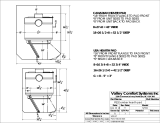The vertical height between the appliance rectangular flue
outlet and the bottom of the chimney structural flue should
not be less than 380mm (15in) and open voids above the
appliance must be omitted by corbelling the brickwork and
flaunching the brick pargery between the appliance and the
base of the chimney flue.
Alternatively, an optional adaptor is available for connecting
the appliance to the chimney flue, to avoid this extra
brickwork and flaunching.
IMPORTANT: FAILURE TO OBSERVE THE
RECOMMENDED MINIMUM SIZES OR METHODS OF
FLUE CONNECTION MAY LEAD TO FUME EMISSION
INTO THE ROOM AND REDUCED BURNING RATES.
Existing Chimney
The internal and external condition of the chimney should
be checked before the appliance is installed and
rectification made where necessary to prevent air leakage
or porosity.
The flue through the chimney should be formed with
200mm (8in) diameter minimum moisture and acid
resistant liners to BS1181: 1971 or precast lining as
specified in the current Building Regulations 1985 and
requirements in BS6461: 1984 Parts 1 and 2 should be
observed.
When repairing existing chimneys, it is recommended that
the Building Inspector be consulted before the
commencement of work with particular attention to the
chimney height and its termination.
THE CHIMNEY SHOULD BE SWEPT BEFORE
INSTALLATION.
An installer must ensure that appropriate protective
clothing is worn/issued when carrying out an installation
that may result in the disturbance of asbestos.
New Chimney
The flue should not be less than 200mm (8in) diameter and
its soundness confirmed by smoke testing or consulting
the district S.F.A.S. who will give advice on the test
method.
Ensure the chimney liners are free of any internal
projections such as building jointing composition before thr
appliance is installed.
Factory Made Insulated Chimney - See Fig. 5
It is recommended that the internal face of the chimney, be
refractory lined and otherwise comply with BS4543. The
recommended minimum diameter is 200mm (8in) and
chimney manufacturers should be consulted for further
advice.
Chimney Terminations
All chimneys should terminate above the roof level in
accordance with current Building Regulations and as
outlined in BS6461: 1984 Parts 1 and 2.
However well designed, constructed and positioned, the
satisfactory performance of a flue cam be adversely
affected by the down-draughts caused by adjacent tall
buildings and trees or even nearby hills. These deflect the
wind creating a zone of high pressure over the terminal
causing it to blow directly down the chimney flue. A
suitable anti-downdraught terminal such as the MARCONE
will usually effectively combat low pressure down-blow but
no known cowl is likely to prevent downdraught due to a
high pressure zone.
Advise the user to ensure the chimney flues are thoroughly
swept at a minimum of 12 monthly intervals after the
appliance is commissioned particularly if bituminous coal is
consistently being burned.
Preparation of Builders Recess Opening
The appliance and recess, hearth and chimney flue
installation should be in accordance with the relevant
recommendations of the British Codes of Practice
BS8303: 1986 and BS6461: 1984 Parts 1 and 2 and any
relevant requirements of the Local Authority.
The appliance must only be installed in a non-
combustible recess in which the hearth must be level and
together with the adjacent walls conform to the current
Building Regulations. See Fig. 2.
The recommended height of recess from hearth level to
register plate is 965mm (38in) and recess depth of
350mm (13
3
/4in) minimum. An allowance of 100mm (4in)
minimum clearance each side of the canopy is required.
The appliance dimensions for the 16” and 18” flue are
shown on the drawings (page 1).
Air Supply
A permanent unobstructed air vent is required having a
minimum effective area of 275cm
2
(42.75in
2
) and
communicating directly to outside air or an adjacent room
which itself has a permanent air vent direct to outside air.
2








